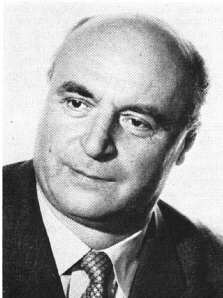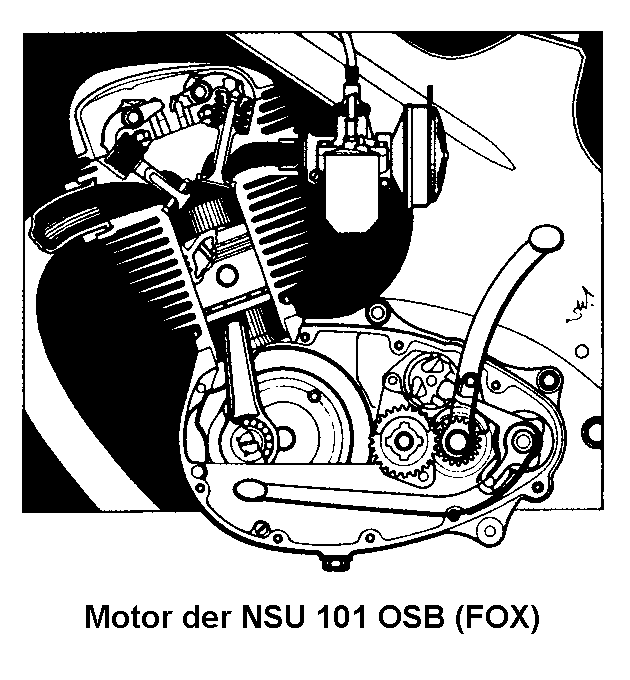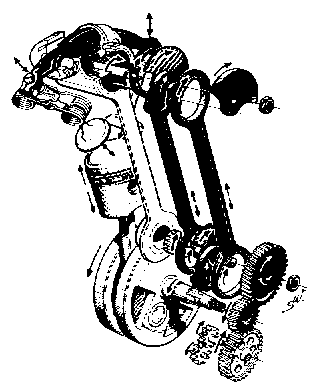|
|
Albert Roder - The man who designed the NSU-MAX |
Almost every Max-rider, who has worked more closely with the technology and the history of his
motorcycle, will be aware that Max has been constructed by a certain Albert
Roder, who was then chief designer at NSU.

But if you ask who this Albert Roder was
actually, and what else did he constructed out of Max, then usually takes only
a shrug. If you ask even someone who has not dealt with NSU, the name is often
completely unknown.
For this reason, will be discussed in more detail on
the designer Albert Roder here. The attention will be paid less in the racing
machine, but rather in the production machines.
First, the short CV: Albert Roder was born on 20 January
1896. In the year 1912 he built his first engine in the age of 16. In 1920
he was co-founder of ZIRO Motoren GmbH in Nuremberg. 1923 co-founder of Erlanger
Motoren GmbH. 1928 as Deputy Head of Development ( under Richard Küchen ) to
ZÜNDAPP. First time in 1936 at NSU under Walter William Moore . End of 1938 as
chief engineer to VICTORIA to Nuremberg, from 1946 until his retirement in late
1961 chief developer at NSU.
On September 3, 1970, died Albert Roder
age of 74 years.
This resume is initially striking that
Albert Roder was not an engineer, has therefore not studied. Nevertheless, it
has been brought to the chief engineer and director of one of the most
important motorcycle manufacturers in the world. A career that is inconceivable
from today's perspective, at least in the automotive industry.
Even more unusual is that Albert Roder
not always followed the path of least resistance in its constructions. His
designs were none that had proved earlier, but he broke new ground in the
development. He also suffered occasional
shipwreck, which it did not prevent him to continue in the rubble.
The best example is the hapless 500 cc four-cylinder racing engine, the engine parts were used for the successful 125 cc
Rennfox.
His work at NSU will begin in 1936. He
has been instrumental in the development of the two- cylinder supercharged
racing engine, which comes to full honors after the war. But Roder is under
Walter William Moore just only the second man at NSU and its constructive ideas
often go in a completely different direction than that of Moore.
It is then quite logical that he comes at the end of 1938 VICTORIA Nuremberg
than you there offers him the awaited position of chief designer.
At VICTORIA he developed the successful bicycle auxiliary
engine VICKY I. But NSU is something else than VICTORIA, and he moves to NSU at
1946, this time as chief engineer and first man since Walter William Moore has
left NSU 1939th.
Now the most creative phase begins in
Roders career. Here, several factors play a role: First, he is now chief
designer and alone determines the technical direction. Second, the
enforced new beginning from the rubble of World War II the unique opportunity to
design completely new start, without having to take on old traditions
consideration. And third, NSU is a major company, which will and is able to
realize Roders ideas.
While the post-war production began with
the reissue of the best pre-war models QUICK, 125 and 251 ZDB OSL, but Roder
already dealt with the construction of an entirely new motorcycle: The FOX.
The FOX - official designation :
NSU 101 OSB - was after IMME RIEDEL the second completely new design in Germany
after the Second World War.
But unlike the IMME who did not meet with commercial success, the FOX was a
bestseller. There were several reasons:

The most important was the engine. Here Albert Roder
had enforced it, in a class where else only two-strokes were offered a
four-stroke engine to build. He killed several birds with one stone: He offered
a performance at 6 hp on the models of the competition, which between 2.5 and
3.5 hp contributed (Only the IMME had 4.5 hp ).
That was enough
to suspend all the other 98s and many 125cc. In addition, the FOX came
with a four-stroke sound that could well were also a much larger motorcycle,
while the competition clanged two clocking.
Finally Roder could
cite a time unbeatable sense argument for the four-stroke engine:
The FOX had unrivaled low fuel consumption and the annoying
oil mix accounted for refueling.
The chassis had new design ideas : The
frame was a highly suitable for mass production
backbone frame. The rear
wheel was conducted in a swing arm with central spring, while the front fork
having a pushed short rocker. All details that were new in the 98er class.
This suspension design - Central steel-press-frame,
pushed short rocker front, rear swing
arm - should be typical of all of the
following NSU motorcycles (up to KONSUL).
The next new development was the LUX.
Her suspension corresponded to this concept, but it was significantly larger
and heavier than the FOX. As drive a newly developed two-stroke engine block
served with 200 cc displacement.
And then
finally followed Roders genius: the MAX. Suspension default they corresponded
basically the LUX, albeit in a reinforced design. But that was the engine
design completely new.
It offered at that time, in
the 250 cm3 class unheard of for a standard engine output of 17 hp ( 13kW ) and
had a number of new design details to:
The biggest news was of course the overhead camshaft ( OHC )
with ULTRAMAX control. Well OHC engines were not something new in racing
engines were common since the thirties. But in a
street
motorcycle that was already sensational.
(Who wants to
watch the ULTRAMAX-rod control exactly can click on the picture . Then it is
loaded in three times better resolution)
The ULTRAMAX-rod control, perfect planned and not a
constructive joke, but had in those times, tangible benefits:
So far overhead camshafts were driven either via a vertical shaft, spur gears,
or a chain. Master shaft and spur gears were tested, but
too expensive for mass production.
The chain drive, as it
is now used in almost every Japanese motorcycle, however, was still in its
infancy. There were so shortly after the Second World War
no reliable high-speed chains available. In particular, they had little
confidence in the durability of the chain in everyday use. It's
just a difference whether a motor has to hold a Grand Prix of 250 km in length,
or 50 thousand kilometers in everyday operation.
The ULTRAMAX-rod engines turned back then
so a real compromise between cost and reliability. From today's perspective, it
would be far too expensive by the unbeatably cheap to be produced chain or
toothed belt drives in production.
Another innovation Roders at the Max was
the air filtration with "Calmed air". Behind it hid a
large positioned before the actual air filter container, which already was able
to sell a large part of the dust before it ever reached the air filter. At NSU
inside the central steel-pressed-frame was added as a container easily used. Until then, they had built a simple wet-air filter in front of
the carburetor, which hung in the air. This wet air
filters were simple wire mesh, which had to be soaked in oil. (Hence wet!) The efficiency of such a filter was strongly dependent on
regular cleaning and immersion in oil. (At the Max
prescribed after 1000 km. Who does that today?) However,
since this work represented a considerable mess, it was like "forgotten" by
the drivers. The dust of the actual air filter has been
greatly reduced by the pre-separation in the frame and protected the engine
accordingly.
The, after Max still following models Superfox and MAXI
were just reduced MÄXE to round out the motorcycle program down . New
constructive ideas are not incorporated here. But one must remember that the
motorcycle business from 1954 declined sharply and it was a matter of survival
for NSU to enter the automobile business.
Roder was concerned at that time already
with the development of a car. First, the three-wheeled Max cabin, but it was
soon abandoned in favor of a proper four-wheeled vehicle. So Albert Roder was
involved more directly in the development of PRINCE 1 to 4.
These vehicles had a two-cylinder
parallel twin engine with overhead camshaft and ULTRAMAX-rod control. At this
time, would actually switching to a chain drive have been useful, but that came
only in 1964 in PRINZ 1000 four-cylinder when Albert Roder was already retired.
From the current at NSU since the late
50's development of the Wankel engine Roder gave way slightly. He is said to
have called a "glowing Germknödel" the Wankel engine. So he left the Wankel
development his assistant and successor Dipl.-Ing. Ewald Praxl and development
chief Dr. Froede.
As Albert Roder was the end of 1961 to retire, he could
look back on a truly fulfilling life as a designer: The constructed racing
motorcycles by him hold ( until August 1958) the absolute speed record and won,
till the voluntary resignation NSUs from Grand Prix racing, all the famous races.
Perhaps more importantly, the he has
constructed series motorcycles were real bestseller and convinced with
performance and reliability. That design was not
fundamentally new more after Max, was because that the motorcycle industry was
in a constant descent from 1954th. This crisis of the
motorcycle industry did not just NSU , but all motorcycle factories.
Here it is Roders merit of helping to ensure that NSU has made
the transition to an automobile factory. Although there is no longer NSU as a
separate brand today, so you should always remember that the factory in
Neckarsulm is persistent and are produced in their motor vehicles.
© Andreas Mehlhorn, extended Version of an artcle
published in MAXFAHERER 1/93.
translated with the help of Google by Stephan
Thum in 2016.
Erwin Tragatsch, "Portrait eines Konstrukteurs: Albert Roder", MOTORRAD, 14.
Jahrgang, Heft 7/1962
Gerhard Geiling, "Albert Roder - Chefkonstrukteur bei NSU in den 50er
Jahren", PRINZENPOST Ausgabe 48
"Ein Jahrhundert Motorradtechnik", VDI-Verlag 1987
Peter Schneider, "NSU 1873-1984 - Vom Hochrad zum Automobil", Motorbuch
Verlag, 1988
Helmut Krackowitzer, "Motorräder, Berühmte Marken von Adler bis Zenith", VF
Verlag, 1988
Herz/Reese, "Die NSU-Renngeschichte", Motorbuch Verlag, 1982
Last update: 26.10.2022